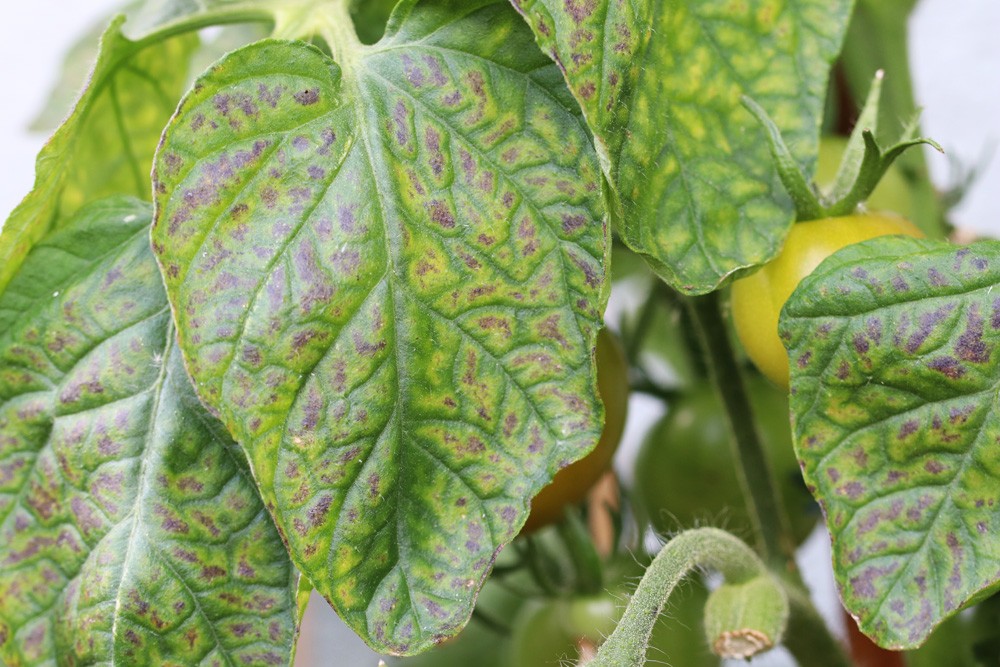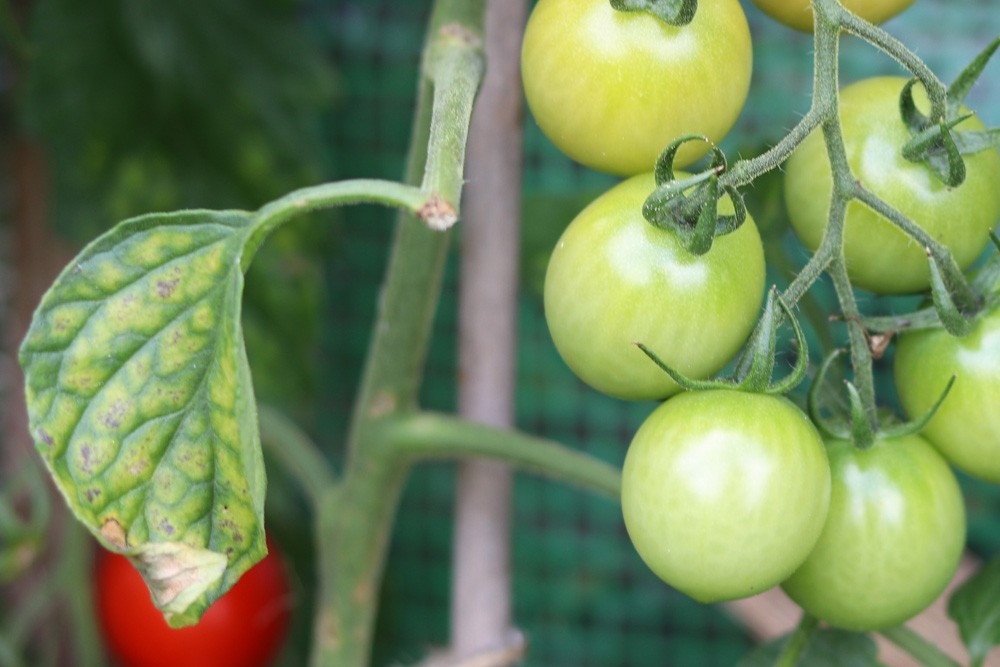The young plants are brought into the greenhouse or bed and some time later the tomato leaves show spots or yellow leaves? Then you need to quickly investigate the cause. Although not every symptom means that a dangerous disease is present – as is the case with humans – it is nevertheless important to find out as quickly as possible what is going wrong.
- Possible causes for yellow tomato leaves
- too much light / sun
- too little light / sun
- too much moisture
- lack of nutrients
- fungi or viruses
In the following, these possible causes will be examined in more detail, so that nothing stands in the way of a lush harvest.
Contents
Light, sun, heat
The hobby gardener is well advised to move his tomatoes to a place that is sunny, but also protected. House walls and eaves have proven themselves for tub plants, plants in the open field, or greenhouse, should be placed so that they are neither exposed to the full sun all day nor are consistently in the shade.
Important:
- Sufficient sun
- Protection from heat
Tomatoes can also get sunburned. The tomato leaves quickly indicate this. Already within a few hours they become light green in their entirety. If the plants are in a pot, this can be quickly remedied by finding a place with more shade. If the tomatoes are in a bed or greenhouse, foil should help to darken them. If the sun was the problem, the plants usually recover quickly. No further intervention should be necessary.
Darkness, humidity, cold
Light green to yellowish leaves will appear if tomato plants are too dark, damp and cold. Other indications are rapid growth and few tomato leaves. In cold weather, the cotyledons turn yellow first. In addition, the stems are thin and brittle. For potted plants, the solution is simple when it comes to the amount of light. Affected potted plants should be watered less and the soil should be checked for odor. In the case of smelly substrate repotting is advised. Essential measures:
- Provide sufficient light and warmth
- Keep shelters and greenhouses clean

Transplant tomato plants
It is necessary to remove everything that turns out light and heat predators, so that the tomato plant gets enough light and sun. Care is more difficult when it comes to “water damage”. While it is easy to prevent excessive watering, nature is not so easy to deal with. Heavy rains, even a lot of dew can cause it to get too wet and discolor tomato leaves. Tomatoes in the open field can be helped only with a canopy. This can be made of any material that ensures that enough light and heat get through. A rich harvest should be possible, if the problem has been identified. Supporting, tying up and removing the yellow foliage will also help.
Nutrient deficiency

Tomatoes are heavy growers. The sufficient supply of nutrients is therefore essential if the plants are to grow healthily and produce a large harvest. If the tomato leaves turn light green or yellow and other damage occurs, the gardener should become a forensic scientist. Depending on the deficiency, a different adversity manifests itself. In the case of a nutrient deficiency, the harvest is also at risk. Fruits become smaller, sometimes inedible, fewer fruits form overall. However, fertilizers should be applied exclusively before fruiting. Otherwise, the tomato may burst or otherwise be damaged.
Common deficiency symptoms
Magnesium
If the tomato plant does not have enough magnesium available, it draws it from older components to incorporate it into the young leaf. The result is that the older foliage turns yellow from the inside – the leaf edge and veins remain green – eventually turning brown and drying out.
Potassium
Potassium deficiency results in the roots not being able to absorb enough water. The lack of water causes the edges and tips of the foliage to turn yellow. If the condition lasts longer, brown leaves appear, droop and dry up – called wilting. The leaves, sometimes the entire tomato plants remain small overall.
Calcium
In the case of a lack of calcium, all the leaves turn yellow the flower rots and dies (blossom end rot). The tips of the shoots can also be affected.
Nitrogen
Cotyledons turn light green, yellow, sometimes even reddish. Older foliage is affected first, dying. Fruits remain small.
Iron
Too much lime in the soil ensures that iron cannot be utilized. Iron deficiency can be recognized by the fact that the tomato leaves turn yellow except for the veins. The image of green net on a yellow background is formed.
Copper
Signs of copper deficiency are leaf tips that turn yellow, curl and die. In addition, the foliage shows brown spots.
Preventing deficiency symptoms
Early fertilizing is a proven way to counteract nutrient deficiencies. The young plant needs one dose immediately after pricking out and a second after about five weeks. Potting soil from discount stores or hardware stores usually contains a slow-release fertilizer. If this soil is used, fertilizing with special agents, such as liquid fertilizer or guano, for example, can be omitted. As soon as the first fruits form, further fertilization should be avoided. Damage to the fruit is otherwise to be expected. A gentle boosting can be done with liquid manure. Nettle and horsetail are suitable for this. Grass clippings can also help to prevent a lack of nutrients through leaching.

Diseases
… can cause yellow leaves and spots on tomato plants.
If the location is unfavorable, diseases of tomato plants can occur. This is fungal infection or viral disease. Yellow foliage, brown to black spots on the stem and fruit are the result. Depending on the type of disease, it may be necessary to destroy the entire plant.
- Ensure sufficient ventilation
- Remove affected plant parts immediately
- Skim milk can help to overcome the infestation
Leaf spot disease is a common fungal infestation. About five millimeter large, watery, spots are formed. These are gray on the inside and dark on the outside. The leaf soon turns yellow and dies. The disease starts at the bottom. The fruit is not affected. However, losses in harvest must be accepted. Other fungal diseases include drought spot disease, fruit and stem rot, late blight, and powdery mildew. All diseases show spots and yellow foliage. Fruit blight varies in severity. In powdery mildew, the berry is not affected. In all other diseases, affected fruit becomes inedible. Affected plant parts should be removed immediately and destroyed! In the case of fruit and stem rot, the entire plant should be discarded to prevent it from spreading. Tomato wilt is caused by bacteria, and tobacco mosaic virus is another disease. In all cases, spraying the tomato plant with skim milk can help control spread.
Tips
- Choose a location that prevents prolonged wetness
- Prevent overly herbaceous growth by pruning out the plants
- Do not plant tomatoes too close together, maintain a plant spacing of at least 70 centimeters
- Do not grow tomato plants in close proximity to other nightshade crops, such as potatoes, to prevent transmission
- Do not water excessively
- Do not use seeds from infested plants
- Change location annually if possible, avoiding locations where other nightshade plants were previously located.
- Disinfect tools regularly, climbing aids after harvesting










